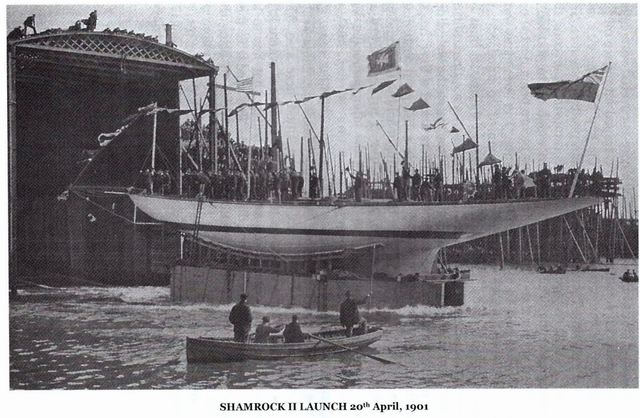
The world's oldest working model experiment tank (1882) on the site of the William Denny shipyard (1844-1963)
Castle Street,
Dumbarton
The oldest surviving ship model experiment tank in the world was inspired by one built by William Froude at Chelston near Torquay which in turn followed on from smaller examples at Aberdeen and Troon.
Froude established a formula to determine the resistance of a vessel, which prompted Dumbarton shipbuilder William Denny to send him the lines and progressive trial results of a single-screw steamer Merkara for tank-testing. The results compared so well that Denny persuaded his partners that it would be commercially advantageous to have their own tank. Architect John Crawford would go on design the tanks at Clydebank and Nagasaki. William Kelso supplied the recording truck for towing the model here and all over the world. John McDowall came up with the wax model cutting machine.
The completed tank and apparatus cost £6k and was originally 73 x 6.7 x 2.75 metres with additional docks at either end. Frank Purvis and Edwin Mumford ran the first model test on 21 February 1883. Denny dedicated the facade to Froude's memory, defining the tank's function as to determine with commercially acceptable accuracy the power required to achieve the contract speed and to reduce that power for any installation to a minimum.
A fire in 1924 gave the opportunity to extend the deep-water section to 94.5 metres and move the suspension links further out to give a clear walkway. Staff of 17 comprised experimenters, analysts and traders, model-makers and mechanics. The tank was purchased in 1964 by Vickers-Armstrong and a wind tunnel added in 1975. It passed into the hands of British Shipbuilders in 1977, and six years later the National Maritime Museum instigated a scheme to save it for posterity. The Scottish Maritime Museum purchased it in 1984 and suitably converted it for public access.
Originally towed by a steam-powered wire rope, the truck of the narrow-gauge railway suspended from the roof went electric in 1908, and has been upgraded over the years. Its equipment records the power, speed, shrinkage and trim of the model. A dynamometer measured the thrust and torque of up to four propellers in open water and behind the hull. Finally, a computer was mounted to drive the model at the required speeds and record all the data.
The wave-maker was upgraded from something akin to Roman slave galleys to more sophisticated designs. Paddle-wheels were tested, and also on display are model propellers that it took a skilled technician a week to cast, fair and balance.
A double-ended brass model made in 1930 was run periodically to ensure that results were consistent, and its resistance curve can be seen in the drawing office. Model resistance was determined by running it first without and then with appendages and finally the propellers were fitted. Mumford experimented with helicopters which were tested in the hills above Overtoun and at the foot of Dumbarton Rock.
The moulding and shaping room allowed models moulded in clay to be cast in specially refined paraffin wax containing 0.5% beeswax, then after setting overnight floated out onto the cutting machine, then transferred up to the finishing room for fairing, checking and polishing.
By 1950 over a hundred warships were fitted with Denny-Brown fin stabilizers whose design drew on Japanese and Russian inventions. Denny had been first to introduce progressive speed trials over the measured mile, and until 1939 homing pigeons were used for transferring the trial results to the tank for analysis.
Experiments extended to submarines, anti-mine paravane cutters, Thomas Lipton's yachts, barges and finally the Denny Hovercraft. In 1950 the old paddle-steamer Lucy Ashton was used to examine Froude's law of comparison for frictional resistance.
The Hovercraft made it to London, but failed to attract the necessary interest as the fixed skirts scooped up river debris when demonstrated on the Thames in 1963. In 1988 the Department of Naval Architecture of the University of Strathclyde began using the Tank, fitting a state-of-the-art motion capture system, a new controllable wave maker and an absorbing beach which opened the door for a number of research and commercial testing projects until financial constraints led to removal in 2006.
Situated in the grounds, in what was formerly the garden of the Denny yard manager's house, is the first marine steam engine built by Robert Napier of Dumbarton in 1824. Fitted in two paddle-steamers, it was presented in 1877 to the Town of Dumbarton, and sat outside Dumbarton Castle and then in the town centre before being located here in 1985, and is the third oldest in the world to be preserved.
Text from Craig Osborne, with our thanks.


Canberra was fitted with a bulbous bow following successful trials at Denny's tank



In 1950 old paddle steamer Lucy Ashton was used to examine Froude's law of comparison for frictional resistance by comparing with models made by six other tanks.

Official Guide leaflet available for download here © Scottish Maritime Museum
The Red Wheel plaque was unveiled on Wednesday 22nd March 2023 by Elliot Witherow DL together with David Mann, CEO of Scottish Maritime Museum and Mike Lunch, NTT Trustee. In May 2024 it was installed on the railings outside the building to be visible to passers by.


Photo Credits: John Yellowlees, Scottish Maritime Museum, Google streetview, Library of Congress det.4a15243 Wikimedia Commons, Chris Allen / Engine of Paddle Steamer Leven, Dumbarton / CC BY-SA 2.0, Bernard Gregory via Pinterest, Ewan Crawford, David Mann - with thanks
Rail – Take the Edinburgh to Helensburgh Central train, get off at Dumbarton Central, and the museum is five minutes from the station.
Road – Use Postcode G82 IQS for satellite navigation systems; or follow signs from Glasgow, take A82 Great Western Road, then A814 sign posted Dumbarton road. Follow brown tourist signs at roundabouts, left on Church Street and again left onto Castle street.
Direct navigation links:
what3words address: ///zest.chose.prop